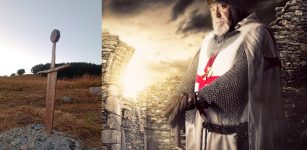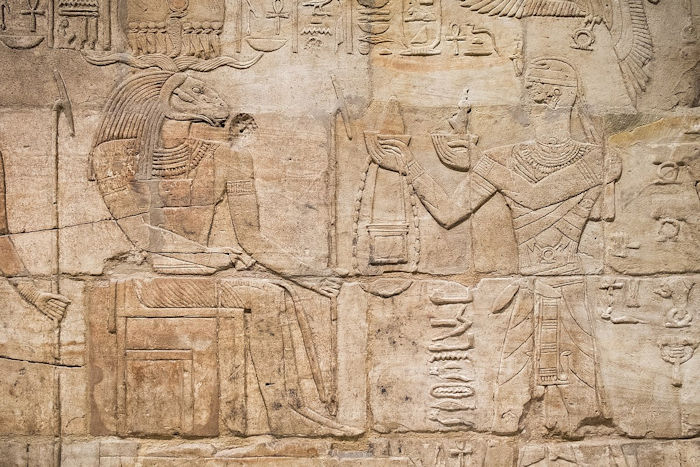Taharqa – The Most Powerful Of The Black Pharaohs
Ellen Lloyd - AncientPages.com - Ancient Egypt is often depicted as an autonomous, stand-alone realm that remained untouched and unaffected by its surrounding African cultures.
There is, however, historical evidence that the balance of power shifted, where the cultures of Egypt and the rest of Africa met and mingled, prompting a revival and reinterpretation of Egyptian customs, gods, and cultural modes of expression.
Taharqa as a sphinx. Credit: Wikipedia/Louvre Museum - CC BY-SA 3.0
For more than 2,000 years, Egypt was the stronger player in the balance of power between itself and its neighboring kingdom to the south, Nubia.
Taharka was the most powerful of the black pharaohs
Taharqa was the son of Piye and the cousin and successor of Shebitku. He was a pharaoh of the Ancient Egyptian 25th dynasty and king of the Kingdom of Kush in Northern Sudan. He reigned between 690 and 664 BC.
Taharqa, "The Black Pharaoh," focuses on a particular chapter in the history of Egypt: from around 750 BCE and in the century that followed, the Nubian rulers upset this balance, seizing the power of Egypt.
Taharqa - life and death of the pharaoh
When Shabaka conquered Lower Egypt and became Nubian king, he was accompanied by his nephew Taharqa, who was about age 20. Later, during Shabaka's reign as pharaoh, Egypt confronted the growing might of Assyria on the battlefield.
During this encounter, Taharqa was at the head of the Egyptian army. However, from a historical point of view, it remains unclear whether the two forces fought. Taharqa's brother Shabataka succeeded Shabaka, making Taharqa his coregent to ensure his succession. About 688 BC, approximately 23 years after the Nubian rule had been imposed over Egypt, Taharqa assumed the throne in his own right.
The next few years were peaceful. Taharqa wanted to control and know about significant events in the neighboring Asian countries. He, therefore, decided to move his capital to Tanis in the Delta.
Granite sphinx of Taharqa, 25th Dynasty, c. 690-664 BC. This statue from Kawa (Temple T) in Sudan shows the Pharaoh's face on a Lion figured sphinx, a form of royal representation borrowed from Middle and New Kingdom art. Credit: Narcissistic Nubian - CC BY-SA 4.0
By 671 BC. Egypt and Assyria again approached a confrontation, so Taharqa prepared to fight for the continued survival of Egypt. But the Assyrian king, Esarhaddon, crossed the Sinai Desert and defeated Taharqa's army on the frontier. In 2 weeks, he was besieging Memphis. The Egyptian military crumbled under the attack of the better-disciplined Assyrian army, armed with iron weapons.
Taharqa fled to Upper Egypt, leaving Esarhaddon to take control of Lower Egypt. Two years later, Taharqa returned with a fresh army and managed to recover possession of the Delta. Still, this success was short-lived, and Esar-haddon's successor, Ashurbanipal, drove Taharqa south again.
It was his final defeat, and he never again tried to campaign in the north. Egypt then entered into a long era of successive foreign rulers.
Taharqa was described by the Ancient Greek historian Strabo as having "Advanced as far as Europe" and (citing Megasthenes) even as far as the Pillars of Hercules in Spain.
Taharqa offers wine jars to Falcon-god Hemen. Image credit: Guillaume Blanchard. Credit: Credit: Wikipedia/Louvre Museum - CC BY-SA 3.0
In biblical depictions, he is the savior of the Hebrew people, as they are being besieged by Sennacherib (Isaiah 37:8-9, & 2 Kings 19:8-9).
Taharqa died in Thebes in 664 BC and was buried at Nuri - North Sudan. His successor was Tantamani, a son of Shabaka.
Evident archaeological traces of the Nubians in ancient Egypt
During his period of Egyptian rule, Taharqa encouraged many architectural projects. The same can be said about his Nubian predecessors. He erected monuments at Karnak, Thebes, and Tanis in Lower Egypt and built several prominent temples in Cush, Egypt's neighbor to the south. Cush played an important role in biblical history.
Pharaoh Taharqa and the gods of Thebes. Standing on the left, he offers "a white loaf" to his father Amun-Re, who is accompanied by Mut, Khonsu, and Montu, Kawa Temple. Credit: Anthony Huan - CC BY-SA 2.0
According to 2 Kings 19:9, "Tirhakah, King of Cush," came to the aid of Hezekiah against Sennacherib, king of Assyria, when his forces laid siege to Jerusalem in 701 BC.
Without such aid, it is hard to imagine that the Kingdom of Judah would have survived.
Taharqa's large temple in Kawa was built on the orders of Taharqa and dedicated to the sun and fertility god Amun-Re. It was intended to give help Taharqa in ruling over his vast kingdom.
It was abandoned in the 3rd century AD and lay buried in sand until excavations in 1930.
Taharqa's shrine is the largest intact Egyptian building in this country.
Archaeologists excavating in Egypt have discovered temples with Nubian inscriptions and highly sophisticated Nubian artifacts inside tombs and palaces. Many archaeological finds were excavated in Meroë and Kawa in present-day Sudan.
Granite statue of Amun in the form of a ram protecting King Taharqa, British Museum. Credit: Rama - CC BY-SA 2.0 fr
Archaeologists and historians have been working hard to preserve the ancient Nubian legacy.
The invading forces from the south appear almost more Egyptian than the Egyptians themselves. Pyramids are built, old traditions and gods are revived, and the new regime appropriates hieroglyphs and Egyptian iconography.
African roots of the Nubians are apparent in connection with their funerary customs and how their culture remained strongly influenced by Egypt even after they retreated to Nubia.
These fascinating findings show that Egyptian and African traits and cultures fuse.
Updated on March 06, 2023
Written by - Ellen Lloyd – AncientPages.com
Copyright © AncientPages.com All rights reserved. This material may not be published, broadcast, rewritten or redistributed in whole or part without the express written permission of AncientPages.com
Expand for referencesMore From Ancient Pages
-
 Ruins Of The Mysterious Kingdom Of Guge That Suddenly Vanished Overnight
Civilizations | Apr 10, 2021
Ruins Of The Mysterious Kingdom Of Guge That Suddenly Vanished Overnight
Civilizations | Apr 10, 2021 -
 Unearthing The Mystery Of The Meaning Of Easter Island’s Moai
Archaeology | Dec 15, 2019
Unearthing The Mystery Of The Meaning Of Easter Island’s Moai
Archaeology | Dec 15, 2019 -
 Who Were Or Are The Ninja – Those Ancient Spies And Mercenaries?
Featured Stories | Jul 3, 2018
Who Were Or Are The Ninja – Those Ancient Spies And Mercenaries?
Featured Stories | Jul 3, 2018 -
 Quest For The Magical Healing Flower In The Garden Of Bakavali Led To A Love Story
Featured Stories | May 28, 2019
Quest For The Magical Healing Flower In The Garden Of Bakavali Led To A Love Story
Featured Stories | May 28, 2019 -
 Teutonic Knights – Facts And History About The Christian Military Order
Featured Stories | Feb 21, 2019
Teutonic Knights – Facts And History About The Christian Military Order
Featured Stories | Feb 21, 2019 -
 New Moai Statue Found On Easter Island
Archaeology | Feb 28, 2023
New Moai Statue Found On Easter Island
Archaeology | Feb 28, 2023 -
 Knights Templar’s Legendary Sword In Stone In Terminillo Mysteriously Disappeared – Where Is It Hidden?
Featured Stories | May 3, 2021
Knights Templar’s Legendary Sword In Stone In Terminillo Mysteriously Disappeared – Where Is It Hidden?
Featured Stories | May 3, 2021 -
 Intriguing Ancient ‘Horoscope’ Scroll Found In The Judean Desert
Artifacts | Apr 2, 2024
Intriguing Ancient ‘Horoscope’ Scroll Found In The Judean Desert
Artifacts | Apr 2, 2024 -
 Khufu Boat And Unique Boat-Building Technique Of Ancient Egyptians
Artifacts | Jun 20, 2017
Khufu Boat And Unique Boat-Building Technique Of Ancient Egyptians
Artifacts | Jun 20, 2017 -
 Three Ingots Shed Light On The Mining Exploitation Of The Sierras de Córdoba Mountain Range
Archaeology | May 8, 2024
Three Ingots Shed Light On The Mining Exploitation Of The Sierras de Córdoba Mountain Range
Archaeology | May 8, 2024 -
 Wars Of The Roses: Thirty Two Years Of Struggle To Claim English Throne
Featured Stories | Aug 5, 2017
Wars Of The Roses: Thirty Two Years Of Struggle To Claim English Throne
Featured Stories | Aug 5, 2017 -
 Climate Change Likely Drove Early Human Species To Extinction – Scientists Say
Archaeology | Jul 31, 2023
Climate Change Likely Drove Early Human Species To Extinction – Scientists Say
Archaeology | Jul 31, 2023 -
 Why Did Neanderthals Visit A Special Cave In Jersey For Over 100,000 Years?
Archaeology | Dec 13, 2016
Why Did Neanderthals Visit A Special Cave In Jersey For Over 100,000 Years?
Archaeology | Dec 13, 2016 -
 Magnificent 2 Meters Tall Marble Apollo Statue And Other Artifacts Found In San Casciano dei Bagni, Italy
Archaeology | Nov 20, 2023
Magnificent 2 Meters Tall Marble Apollo Statue And Other Artifacts Found In San Casciano dei Bagni, Italy
Archaeology | Nov 20, 2023 -
 7.2-Million-Year-Old Pre-Human Remains Suggest Our First Ancestor Came From Europe Not Africa
Archaeology | May 23, 2017
7.2-Million-Year-Old Pre-Human Remains Suggest Our First Ancestor Came From Europe Not Africa
Archaeology | May 23, 2017 -
 Largest Ever Human Family Tree: 27 Million Ancestors Mapped
Archaeology | Feb 25, 2022
Largest Ever Human Family Tree: 27 Million Ancestors Mapped
Archaeology | Feb 25, 2022 -
 Persephone: Greek Goddess Of The Coming Spring And Lady Of The Land Of The Dead
Featured Stories | Jun 26, 2021
Persephone: Greek Goddess Of The Coming Spring And Lady Of The Land Of The Dead
Featured Stories | Jun 26, 2021 -
 3,000-Year-Old Ancient Egyptian Artifact Seized By US Agents In Memphis
Archaeology | Aug 29, 2022
3,000-Year-Old Ancient Egyptian Artifact Seized By US Agents In Memphis
Archaeology | Aug 29, 2022 -
 Large Ancient Egyptian Astronomical Observatory In The Buto Temple Discovered In Kafr El-Sheikh, Nile Delta
Archaeology | Oct 9, 2024
Large Ancient Egyptian Astronomical Observatory In The Buto Temple Discovered In Kafr El-Sheikh, Nile Delta
Archaeology | Oct 9, 2024 -
 Fascinating Virtual Avatar Of Mysterious Egtved Girl Created – What Is Her Story?
Archaeology | Dec 19, 2022
Fascinating Virtual Avatar Of Mysterious Egtved Girl Created – What Is Her Story?
Archaeology | Dec 19, 2022





